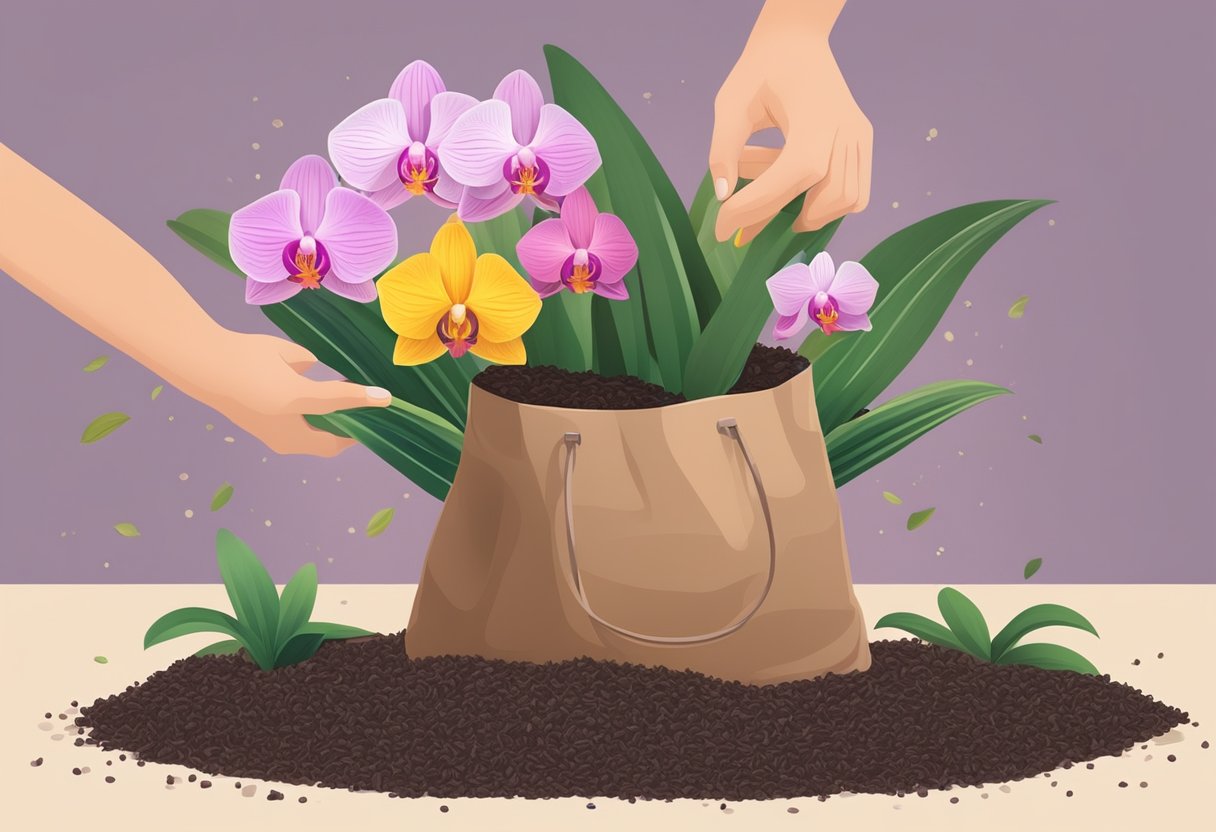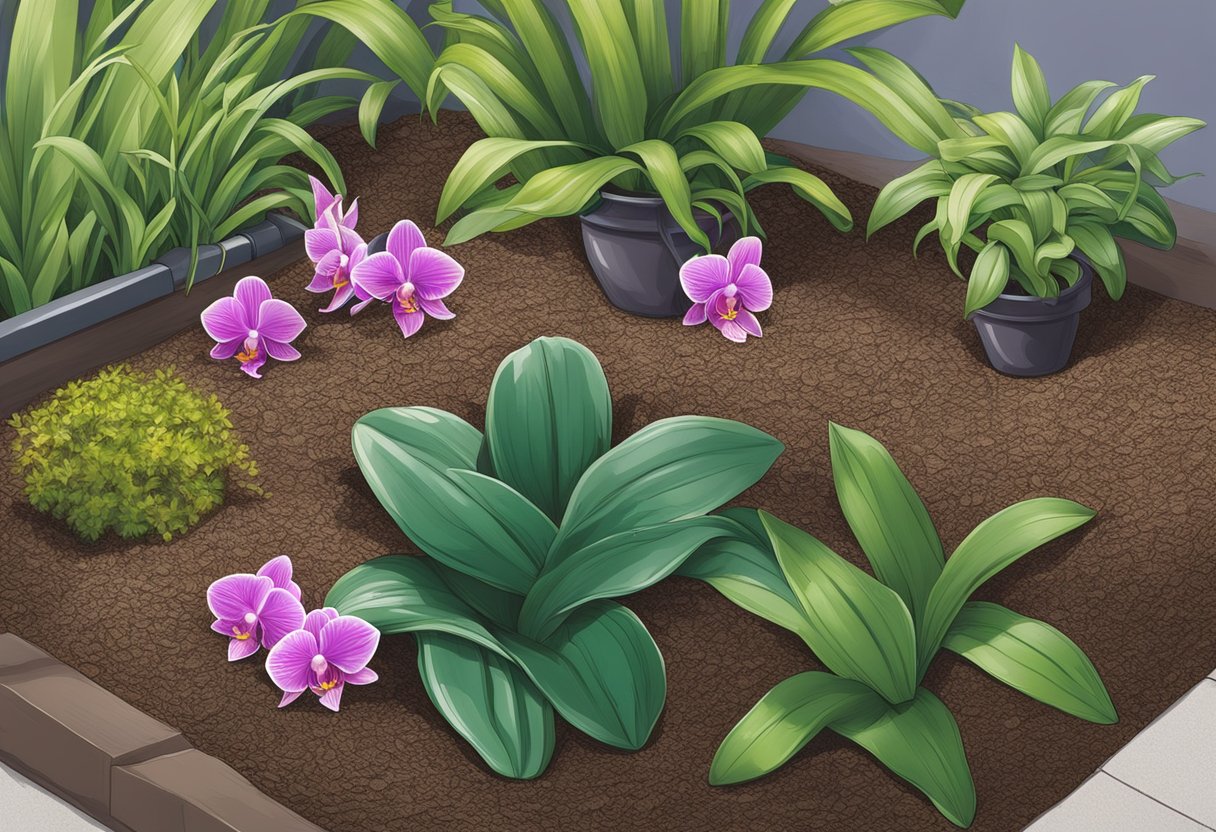When growing orchids, selecting the right potting medium is crucial to their health and bloom quality. Orchids have distinctive growing requirements, and since they are epiphytic in nature, typical gardening soil will not suffice. A good potting mix for orchids often includes fir bark, which provides the chunky texture and ample air space that orchid roots need. It’s designed to mimic the orchid’s natural environment, where roots are exposed to air and a rapid drainage of water.

Our discussion turns to mulch, commonly used in garden settings to retain moisture and reduce weed growth. Its role in orchid care is less traditional. In an orchid mix, materials that are usually considered as mulch, such as finely ground bark or coconut husks, can offer additional moisture retention and air circulation. However, using typical garden mulch as a sole component in an orchid potting medium isn’t advised, because it may not provide the aeration that orchid roots require.
In our care practices, we recommend using specialized orchid mixes that can contain mulch-like components beneficial to orchid health. We understand that while these materials are different from the pine bark chips sold as orchid bark, they can be similar in function, helping to regulate moisture and provide structure to the potting medium. A careful balance of materials ensures that our orchids have the right conditions to thrive, echoing the varied and often highly specialized environments from which they hail.
Choosing the Right Mulch for Orchids

To ensure healthy growth, selecting the appropriate mulch is crucial for addressing the unique moisture and aeration needs of orchid roots.
Understanding Orchid Roots and Moisture Needs
Orchid roots are highly specialized; they require a balance of moisture and air to thrive. Excess water can lead to root rot, while too little can dehydrate and weaken the plant. Our goal is to mimic the natural environment where orchids grow—often on trees with access to plenty of air circulation around the roots.
Comparing Organic and Inorganic Mulching Materials
When we’re choosing mulches, we differentiate between organic and inorganic materials; each influences moisture retention and root aeration differently.
-
Organic Mulches:
- Bark: Provides excellent drainage and aeration. Options include fir bark, pine bark, and orchid bark.
- Mosses: Sphagnum moss retains moisture well, which can be beneficial for hydration but must be used carefully to prevent waterlogging.
- Others: Coconut coir, husk chips, and peat offer additional organic options, each with unique moisture retention and aeration properties.
-
Inorganic Mulches:
- Perlite, volcanic glass, and rockwool improve drainage and aeration but do not retain water.
- Expanded clay aggregate and lava rock are reusable and provide excellent support and drainage.
Mulch Types: Bark, Moss, and Alternatives
Different mulches suit various orchid types and growing conditions.
-
Bark Mulches:
- Ideal for most orchids.
- Types include fir and pine bark, allowing us to customize the mix based on the size of the bark pieces.
-
Moss Mulches:
- Best used for species that need more moisture.
- Sphagnum moss can be mixed with bark to balance moisture retention and drainage.
-
Alternative Mulches:
- Coconut coir serves as a sustainable alternative to peat moss.
- Cork and husk chips are great for creating air pockets around the roots.
- Inorganic options like perlite and charcoal can be added to organic mixes to improve aeration and filtering toxins.
Optimal Orchid Mulching Practices

We’ll guide you through proper mulching to ensure your orchid thrives, focusing on repotting, aeration, drainage, and maintaining the right humidity.
Repotting with the Right Mulch
When we repot, it’s vital to choose a mulch that compliments an orchid’s natural habitat. Bark chips are often favored for their ability to mimic the orchid’s native conditions, providing ample air circulation and preventing root rot. An orchid-friendly mulch should also encourage drainage while holding adequate moisture. A thin layer of mulch on top of the chosen potting mix suffices—beware of any contact with the foliage, as this can invite disease.
Enhancing Aeration and Drainage
Aeration and drainage are critical for orchid health. Here’s our approach:
- Aeration: We ensure the potting mix is loose and chunky. Orchids need space for air to reach the roots.
- Drainage: Select pots with sufficient drainage holes. A proper potting mix containing fir bark, perlite, and sphagnum moss will assist in preventing waterlogging.
We find that increased aeration leads to healthier roots and more vibrant blooms, contributing to an overall stronger orchid.
Maintaining Proper Humidity and Watering
Managing humidity and watering regimes is a delicate dance for orchid success:
- Humidity Levels: We aim to maintain humidity levels between 40-70%. Trays filled with water and pebbles beneath the orchid pots help enhance humidity without wetting the roots directly.
- Watering: Orchids prefer to dry slightly between waterings. In warmer months, watering can occur twice a week, while in cooler months, once a week may suffice. We always check the top inch of the potting mix; if it’s dry, it’s time to water.
Balancing these elements ensures our orchids don’t just survive—they thrive.